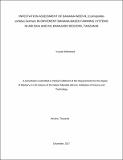| dc.contributor.author | Mohamed, Yusuph | |
| dc.date.accessioned | 2019-05-28T07:01:15Z | |
| dc.date.available | 2019-05-28T07:01:15Z | |
| dc.date.issued | 2017-12 | |
| dc.identifier.uri | http://dspace.nm-aist.ac.tz/handle/123456789/229 | |
| dc.description | A Dissertation Submitted in Partial Fulfilment of the Requirements for the Degree of Master’s in Life Science of the Nelson Mandela African Institution of Science and Technology | en_US |
| dc.description.abstract | The present study was conducted to determine population size, infestation level and farmer’s understanding of banana weevils in different banana-based farming systems (BFS) namely banana monoculture, banana-beans, banana-coffee and banana-maize. This was conducted by using banana pseudostem traps, coefficient of infestation method and standard interviewing. It was conducted from June to September 2017 in Nkoaranga, Mbuguni and Ngurdoto villages (Meru District) and Uduru, Uraa and Mbosho villages (Hai District) in Northern Tanzania. The physical and survey data collected were analyzed by using statistical packages of GENSTAT 11th edition and SPSS Version 21 respectively.
There were significant differences (P<0.05) in the number of banana weevils in different BFS. The highest banana weevil population (29.2 banana weevils/trap/farm over the period of three months) was recorded in banana-maize followed by banana-beans (8.2 banana weevils/trap/farm over the period of three months); however, this reading was not significantly different from the banana-monoculture and banana-coffee farming systems. Such results not only indicated that different BFS experience different banana weevil infestation levels but also that the banana-maize system attracted more banana weevils than any other BFS in this study. Of the banana cultivars, Kimalindi recorded the highest (153 weevils per farm) number compared to other banana cultivars indicating that different banana materials attract differently banana weevils. The results also showed that banana weevil was ranked to be the first insect pest of banana and a problem for about 68.8% of banana farmers. The present study calls for more studies on identifying factors responsible for the highest population in a banana-maize farming system unlike in other BFS and how banana weevils can be managed in Tanzania. | en_US |
| dc.language.iso | en_US | en_US |
| dc.publisher | NM-AIST | en_US |
| dc.subject | Research Subject Categories::FORESTRY, AGRICULTURAL SCIENCES and LANDSCAPE PLANNING | en_US |
| dc.title | Infestation assessment of banana weevil (cosmopolites sordidus germar) in different banana-based farming systems in Arusha and Kilimanjaro regions, Tanzania | en_US |
| dc.type | Thesis | en_US |

